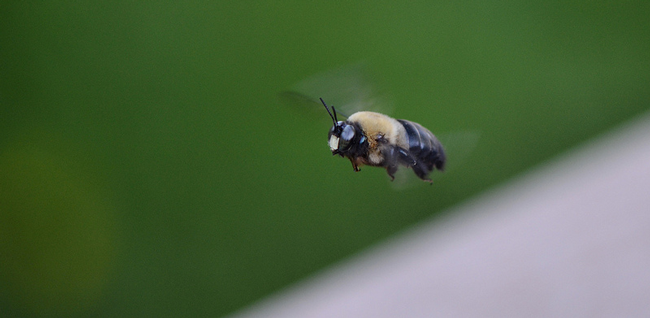Male Carpenter Bees Are “In Your Face,” But Can’t Sting!
By Chris Williams on April 23, 2014.

Question
There are a couple of really big bees buzzing around our back deck. Every time someone steps out on the deck, we’re attacked. I don’t know where they’re coming from. They’re fuzzy yellow on top with a shiny black body. Are they bumble bees? I don’t even know how we can spray them since they never land anywhere, but I want my deck back! M.B., Auburn, NH
Answer
I can’t make a positive identification without actually seeing the pest, but putting all of the variables that you mentioned together, I bet you’re dealing with carpenter bees. Here’s how I know from your description:
1) “out on the deck”
Carpenter bees chew perfectly round, dime-sized nest holes in unpainted or unsealed soft weathered woods like teak, redwood, cedar, or pine. Wooden decks and wooden deck furniture are common nesting sites. If you bend over and look on the bottom edge of deck railings or other boards, you might see the bees’ entrance holes (Hint: the nest will be near where you are being buzzed). They could also be nesting just above in your roofline soffit boards, another common site.
Each nest hole opens into a series of six brood cells which run lengthwise in the wood. Each cell contains an egg and a pollen ball for the hatching larva to feed on. Six adult carpenter bees will emerge from the nest hole in late summer, unless woodpeckers get them first.
2) “we’re attacked”
This is classic behavior for male carpenter bees which, you’ll be glad to know, cannot sting. Carpenter bees are not social bees that live in a colony; each pair constructs a nest. The fact that you have “a couple” of them buzzing you, indicates that you have more than one male or more than one nesting pair in the same area. While the female provisions the nest cells, the male bee is on guard duty. He’s all bluff though; only the female bee has a stinger but she’s very busy and not aggressive.
3) “fuzzy yellow on top with a shiny black body”
This describes carpenter bees. Bumble bees are very similar in size, shape, and color except that their black abdomen is also fuzzy. Carpenter bees have a shiny, hairless black abdomen.
They Won’t Own Your Deck for Long
Fortunately, carpenter bees are not a nuisance for very long. Once the female has provisioned her nest and laid her eggs, she and her mate move on. The whole nest construction process takes about a week.
The down side is that carpenter bees tend to re-use the same nest sites the following year. Their damage to wood is mostly cosmetic and rarely serious unless you have a lot of carpenter bees nesting around your house. Woodpeckers trying to feed on the fat larvae in the wood cause most of the damage (see “Woodpeckers and Carpenter Bees”).
You can have an exterminator treat the bees’ nest holes. This will kill the female if she is still returning to the nest and will eliminate next year’s carpenter bees that would emerge from the nest. You can also discourage carpenter bee nesting by painting or sealing the wood.
Photo credit: HolleyandChris / Foter / Creative Commons Attribution 2.0 Generic (CC BY 2.0)